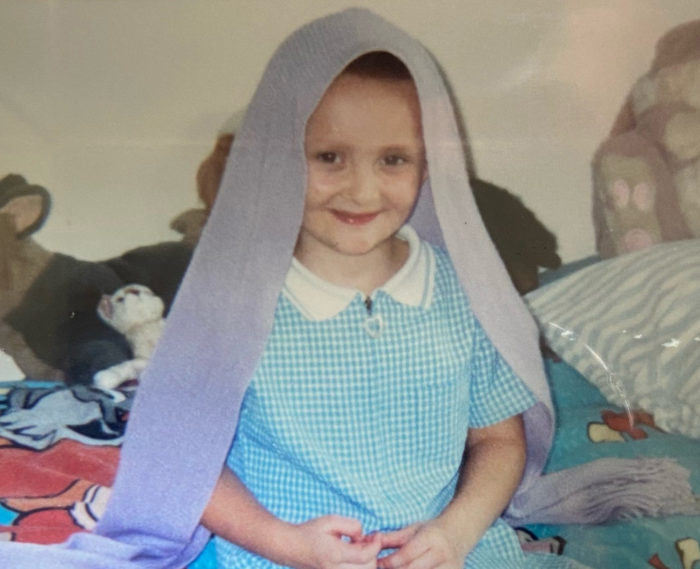Bone grafts. Dental implants. Sinus lift. Crowns. Charlotte Smith has spent a lot of her life sitting in a dental chair. Affected by hypohidrotic ectodermal dysplasia (HED), half of her teeth didn’t develop. And the ones that did were misshapened.
All those long hours of treatment not only led to her beautiful smile, they also inspired her career aspirations. The 22-year-old from London, England, is a dental nurse who works for an oral surgeon. She chose the profession due to her ectodermal dysplasia.
“Going to the dentist has been such a bane of my life. I wanted to turn that into something positive,” Charlotte said. “I want to work with kids. If I can change one person’s life, I can help.”
With no history of HED in her family, Charlotte continues to learn about her condition which was diagnosed when she was four. She has not met another affected individual – yet.

Managing the Heat
She finds her inability to sweat to be her biggest challenge right now.
“I’m very active and I try to hide that I can’t sweat. But, it’s hard. I overheat daily and it’s worse having to wear the PPE (personal protective equipment) at work. I get anxiety about it and that can make it worse. It’s tough to pick out what to wear. I can be overheating on a daily basis. Some days, it feels like my head is going to explode.”
Once she’s overheated, it can take 10 minutes or more for her body temperature to come down. Fortunately, her work is very accommodating. Sometimes she sprays her face.
Keeping her feet cool is a big help, especially during the summer when the humidity is worse. And it’s not just adapting to heat that can be tough. Like many people with HED report, when the weather gets colder, her body has a harder time adapting.
Finding Hair Options that Work
Wearing wigs can also turn up the heat for Charlotte. Since she was little, her hair has been thin. It grows to a certain length but then stops. Growing up, she never considered wearing a wig. Fortunately, she never experienced any bullying for her sparse hair. At age 10, her hair started getting a little thicker and longer.
When she got to college, she decided to try wearing wigs. But, they were hot. She began experimenting with different techniques for her hair.
“In college, my friends were getting hair extensions so I started them. My hair would shed and the extensions were always falling apart. A black friend suggested I try a weave. I tried it and it was so nice! I used a weave in the summer. I could put my hair up and it was a relief from the heat. I could wear it on holiday or at the sea and it wouldn’t come off. “
If your hair is strong enough, a weave is good for a couple of weeks but then breaks off, Charlotte said. You can do it with short hair, too.
Hair = Confidence
But, after a while, Charlotte needed a new option and looked into human hair wigs.
“I went to a good place where actors go to have a wig hand made from human hair. I have two that I rotate. I spent a lot of money on them. I wear a shorter one for work and wear a longer one outside of work.”
She uses Ellen Wille human hair care kit for her wigs. Charlotte leaves the treatment on wet for 24 hours then rinses it. She avoids washing it too much.
Charlotte says having hair gives her a lot of confidence.
I won’t go without it. If you feel insecure, try a wig. Some have clips all around so it won’t come off. It depends on how it’s made. If you don’t want to wear a wig, you can dye your hair dark to help make it appear thicker. That’s a tip I learned.
– Charlotte
A Bright Future
Charlotte dreams of making her own wigs someday. She might work with kids, but is not sure doing what. Being a sociable person, she loves being with her big group of friends.
Having ectodermal dysplasias has made her an adaptable person.
“I have to be adaptable to changes because it’s constant in my life. You develop a thick skin.”
Despite the issues that HED presents in her life, this young woman keeps a positive attitude.
“I don’t take for granted what I have. At my job, I see people who don’t have a full set of teeth. I’ve learned to be grateful for what you do have.”

My name is Sam, I’m 24 and I also have ED. Similar conditions except I only ever grew 1 tooth so living with a full set of dentures my whole life has not been easy. Growing up all I ever wanted to do was sport and not being able to sweat at all made this challenging! I have never met anyone with my condition so would be very happy to meet charlotte if she wanted to?
Hi, Sam. Feel free to contact me at kelley@nfed.org if you would like to be connected with others affected by ectodermal dysplasia.
Be merry and well,
Kelley Atchison
Director, Family and Community Programs
My grandson noah is 5 an he has hed,ther is no one in our town with hed we would love to meet some on!!we live in sandyrun sc
Hi, Lorriane. You can Connect with our Community at https://nfed.org/get-involved/connect-our-community/ or contact me at kelley@nfed.org.
Thanks!
We live in Charleston South Carolina… I have grandson sarah call 4 1/2 and six to both have each day. We would be happy to meet with you 🙂
Hello,
My 4 year old granddaughter has AEC. I never see any articles regarding AEC on the NFED website. Is there any help for her skin and hair growth. I assume that it’s quite rare and there isn’t much research on it. Thank you.
Hi, Donna! Thanks for connecting with us. I did a quick search for blogs related to AEC, and you can see what comes up following this link: https://nfed.org/?s=AEC.
Additionally, you may find some more helpful information on our AEC page: https://nfed.org/learn/types/ankyloblepharon-ectodermal-dysplasia-cleft-lip-palate/.
In regards to skin and hair growth, because these symptoms affect many of the ectodermal dysplasias in addition to AEC, check out our symptoms pages for both skin and hair, which you can find at the links below. If you have more specific questions, feel free to email us at info@nfed.org, and we can see what resources we have for you.
Hair symptoms:https://nfed.org/learn/symptoms/hair-symptoms/
Skin symptoms: https://nfed.org/learn/symptoms/skin-symptoms/
Hopefully, these articles can be a place to start, but please let us know if you have other specific questions!
Best,
Veronica